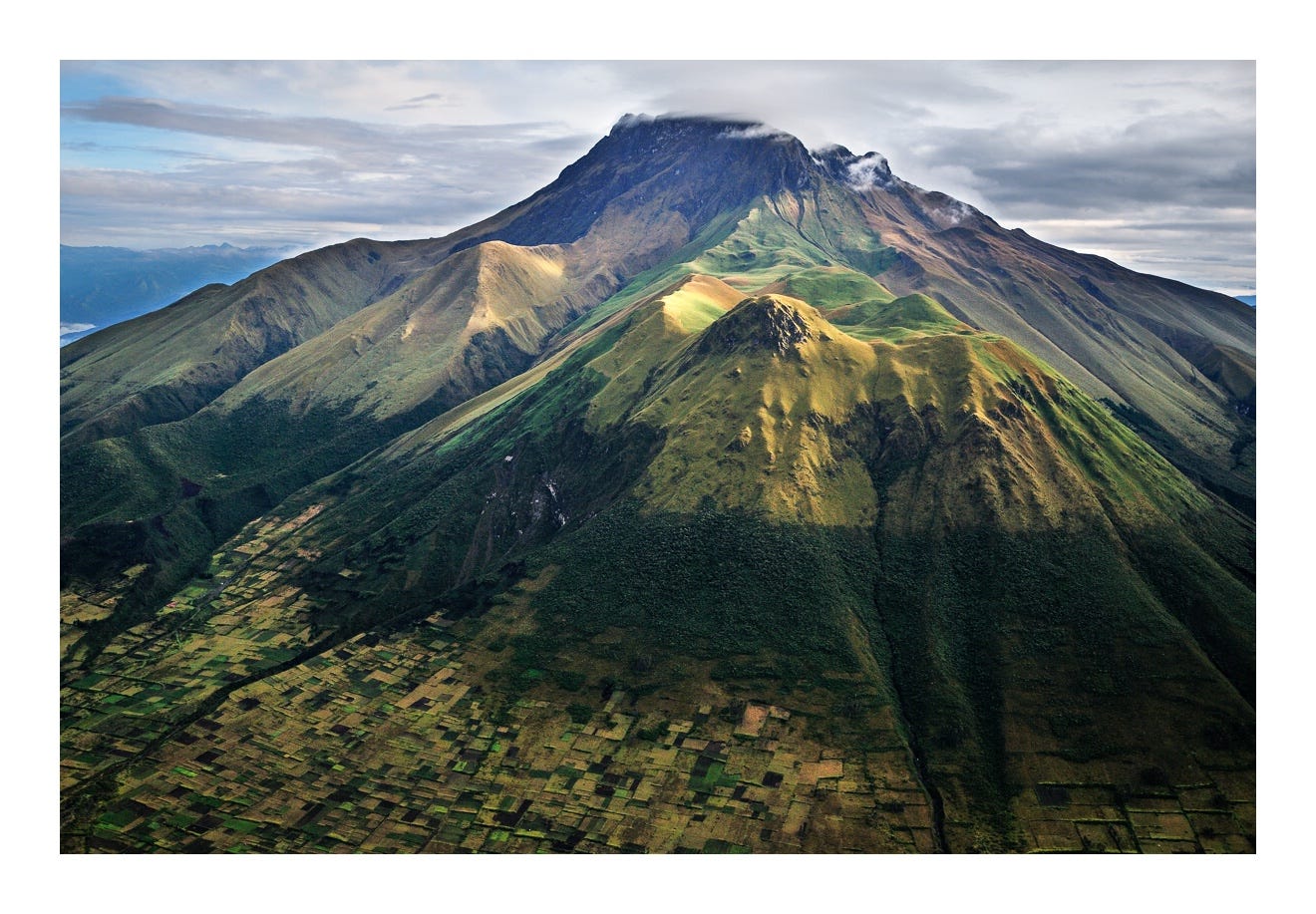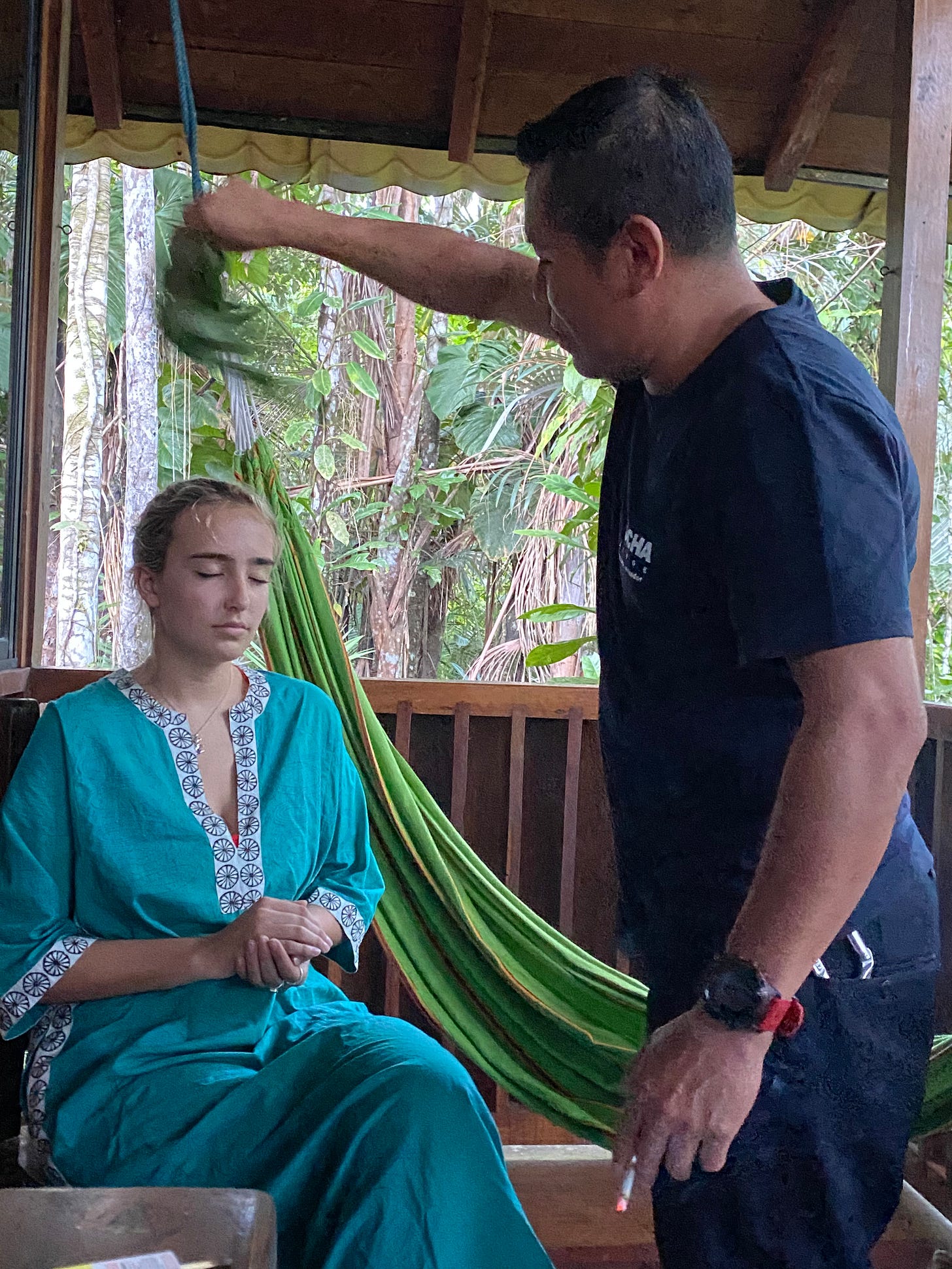A Virgin, a mountain and some plants...
Notes on"Cleansing" your sorrows away, weaving and animism in the Highland Andes
Hi friend,
It has been a while, a bout with the flu and the devastatingly sad situation in the Middle East had me down and out. Between the global malaise and the flu I have healing on my mind so for this newsletter I want to share some thoughts on that subject….
The anonymous, circa 1730 oil painting pictured above is from Bolivia and has always been a favorite image of mine. Thirty years ago, as a grad student of Latin American Colonial Art I was always fasciated by the confluence of religion, nature and the spiritual realm in the Andes. This summer I inadvertently did some field work in the region— proving that 500 plus years after 1492 this dance between the natural and spiritual realm has not changed. When the Spanish Empire “converted” the indigenous population of the Andes they had a hard time with the nature of their spirituality— one where nature and gods are symbiotic, something art like this mountain painting attempted to tackle.
In this work the Virgin Mary is depicted as a mountain, you can see her hands on either side, and she is flanked by Jesus, the Holy Spirit and God, just below that plane is the Sun (Inti) and the Moon (Quilla or Moon Mother, the wife of the Sun). In Spanish most things have a gender, likewise in the Andean belief system the Earth, like the moon, is feminine, (Pacha Mama). The mixing of different religions or spiritual traditions is sometimes know as religious "syncretism" — the mash up between celestial bodies, Catholic deities and Nature. P.S. If you look closely at her “skirt” you can see the depiction of the Inca king, farmers, plants and life in the Andes. I spent my childhood in these mountains and I take great joy in bringing people to Ecuador in the summers to experience this rich culture first hand.
Last summer I led a group of travelers on a trip through the Ecuadorian Andes and the Amazon Rain Forest. For one year I meticulously planned every detail and was certain that I had prepared a memorable trip centered around artisan-made textiles and birding, but at the last minute four people dropped out and it turned out to be a journey of healing. I had planned much of the activities around the interest of those people so suddenly I had the freedom to pivot. The first part of the trip stayed the same, centered on visiting the master artisan weaver picture here, Matilde Lema aka Doña Matico.
She is a midwife, feminist, domestic abuse survivor, community healer, mother, grandmother and master artisan from Peguche, Ecuador, but to me she is a role model and dear friend. She lives and works in the region of Imbabura, which was the first stop on our summer trip. This region is known for its weaving and was point zero for the Colonial-era textile mills, aka “Obrajes.” Matico’s grandparents were indentured servants who worked at these mills, they were master weavers who passed down their skills to her in childhood. Matico is a natural-born healer (she told me how a vision that came to her in a dream, a “knowing” as she described it, that her grandmfather later confirmed was a sign of a gifted of healer). He changed her name from Matilde to Matico, after a powerful Andean medicinal plant used to stop bleeding. When she was fourteen the “Andean Mission” - a program of the Kennedy administration - came to her town, and it was there were she learned to be an auxiliary nurse and a midwife. But by age fifteen, in accordance with the misogynist customs of the region, she was forced to wed a man ten years older than her because she dared to speak to him without the permission of her father. In the years that followed she had five children, whom she supported with the proceeds of her weavings. Her husband was an unfaithful, abusive alcoholic who she divorced after 35 yrs of misery, at fifty two. Watch this clip where she discusses her work and our collaboration.
After Covid she told me how she had protected and cured many people in her community, yet she categorically refuses to call herself a “shaman” despite her vast knowledge and use of traditional herbs and healing modalities that have restored harmony to the sick and anxious of her community for decades. Her treatments were done primarily for family and members of her community, not for tourists. In the almost nine years In have known and worked with her, only once did she perform a blessing on me, so I had reservations about asking her for more despite knowing her healing gifts, until last summer…
Since the Ecuador trip I led had shrunken in size, I asked everyone who made it what they were really there for besides an eco adventure. Most people wanted answers to past trauma, I knew that the powerful region of Imbabura was the ideal place to witness and heal old wounds. Matico’s town is on the foothills of the mountain seen here, it is known as Taita Imbabura - taita is a Quichua word for father. This volcano holds a pivotal role in the mythology and history of the region's indigenous communities who consider Imbabura a protective deity and a source of life, a father.
I summoned the courage to ask my friend Matico if she would perform a reading and then a cleanse for three people in my groups, and she graciously said that because they were my friends she would do it! A “limpia” or spiritual cleansing, is performed in the Andes to cleanse the body, mind and soul of negativity. It is known to remove bad luck, blockages, reverse bad karma, counter witchcraft, end generational curses, help with addictions, phobias, and fears. What most stood out to me about the ceremonies that I witnessed translated last summer was the syncretism and role of Christianity in these very Andean rituals. There was not one minute in the whole process where God, or Jesus was not thanked and praised by Matico. Before the ritual started she recited a long prayer inSpanish , later her assistant Carmencita repeated the invocation in Quichua. They moved seamlessly between the two languages, as they invoked Jesus, God the father “diosito padre” and the surrounding mountains, all while using native medicinal plants, incense, eggs, palo santo and even a guinea pig as tools.
(photo caption: 1. Matico in her beautiful garden where she grows many of the plants used in ceremony. 2. My friend Alicia getting bad spirits removed via medicinal plants by Carmen. 3. My friend Jonnyka during another ceremony with a male healer who used volcanic rocks to move energy. 4. A final blessing for Alicia by Matico and Carmen.)
Some final notes on Andean healing:
In the Andes “healing,” weaving, and spirituality are animistic, this essentially means that things in physical realm (plants, mountains, humans, rocks etc) also have spiritual energy and intelligence, and they co-exist in the everyday world.
During the healing that Matico performed she talked about espiritus - spirits- and energia - which is critical to Matico who said that if people ask for a healing and they have mala energia she will refuse, unlike the more commercial shamans who just do it for profit. Her treatments work on an energetic plane and they help rid the person of evil spirits that can sometimes travel to earth via the wind and stay logged in our mind and body- something known as susto or a fright, a scare. Susto is defined in medical literature as “a cultural explanation of distress and misfortune in Latin America that refers to an illness attributed to a terrifying event that causes the soul to leave the body and leads to unhappiness and illness, as well as difficulties in performing key social functions.” This causes distress and dis-ease. BTW a cleanse is performed all over Ecuador and Latin America, here is recent picture of a healer in the Amazon performing a limpia on my daughter.
(photo caption: my daughter Anna in 2021 during an limpia or spiritual cleansing in the Amazon Rain Forest)
Finally, I see so much cultural appropriation when it comes to “healing” in the Global North. I don’t know how many images I see on Instagram of Western “shamans” or “light workers” wearing indigenous headgear, burning palo santo and guiding people though plant ceremonies including Ayahuasca. I am not saying healers are exclusive to this area, but when I see elements from the Amazon or the Andes used as decoration and props my skin crawls. I am not here to judge, but when you witness someone like Matico who was born in the region, has ancestral knowledge that comes from her grandparents, years (in her case over seven decades) of experience vs. someone who had a mystical plant medicine trip and is suddenly a “shaman.” White-washed healing for the Tolum set makes me low-key cringe as my teen daughters would say. Especially when it is all taken so out of context without acknowledgement of the staggering socio economic unbalance of power or the level of privilege it takes to charge exorbitant rates to perform ceremonies that have their roots in the Global South. I have spoken to many healers in Ecuador who lament the commercialization of their work, and so I just want to bring attention to the elders, because, in my opinion, they are the true, “authentic” healers. I said what I said. I am so grateful to know Matico and to see that despite the rampant globalization and erasure of culture we are witnessing, some things remain the same.
**A final note on Andean artisans I have collaborated with since 2015…
In the Andes no separation exists between weaving, healing and the natural world. In the region, for thousands of years, cultural identity is manifested via textiles, and, more specifically, their clothing system, which despite over 500 years of colonialism stands as an act of resistance and faith. You can see this in the clothing Matico wears daily.
She faced numerous challenges in establishing her workshop, Warmi Maqui which means "the hands of women", including the universal female issue of juggling family and work. Matico faced much social alienation for divorcing and then running her own business in a patriarchal society where spousal abuse is accepted as part of the male dominated culture. In addition, as business women she encountered difficulty teaching people the real value of artisan-made goods, especially in an environment where cheaper Chinese made goods currently flood the market. Thank you for your time, when you travel always buy goods directly from the people who make them or through someone they partner with equitably!
(photo caption: Matico and her best friend Lola in her workshop)










